Essay: Legal and Ethical Issues in Nursing - HEALT1113 Course
VerifiedAdded on 2022/10/19
|9
|2234
|107
Essay
AI Summary
This essay delves into the legal and professional issues within the nursing field, emphasizing the importance of effective communication. The essay begins by highlighting the significance of building rapport with clients, detailing strategies such as active listening and cultural sensitivity to establish trust and facilitate open communication. It then identifies various communication strategies, including focusing on the issue, maintaining honesty, and demonstrating empathy. The essay further examines barriers to effective communication, such as psychological and physical factors, and proposes methods to overcome these obstacles, like active listening and using clear language. Ethical considerations, including honesty, accuracy, and respect, are also discussed, along with the roles of other healthcare professionals and the importance of professional communication standards. The essay concludes by summarizing key points and emphasizing the challenges of interpersonal communication and the need for verification to ensure messages are understood correctly.
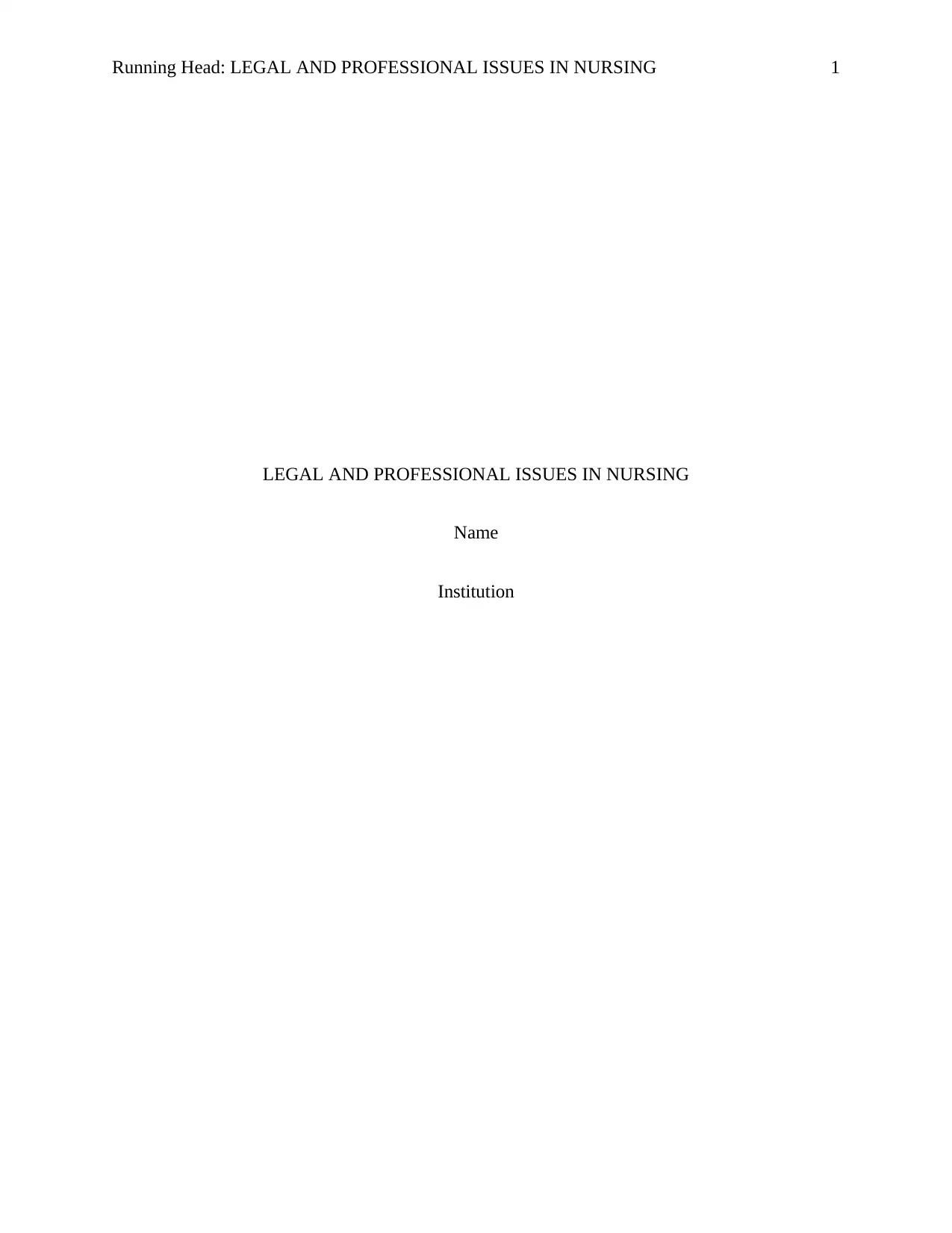
Running Head: LEGAL AND PROFESSIONAL ISSUES IN NURSING 1
LEGAL AND PROFESSIONAL ISSUES IN NURSING
Name
Institution
LEGAL AND PROFESSIONAL ISSUES IN NURSING
Name
Institution
Paraphrase This Document
Need a fresh take? Get an instant paraphrase of this document with our AI Paraphraser
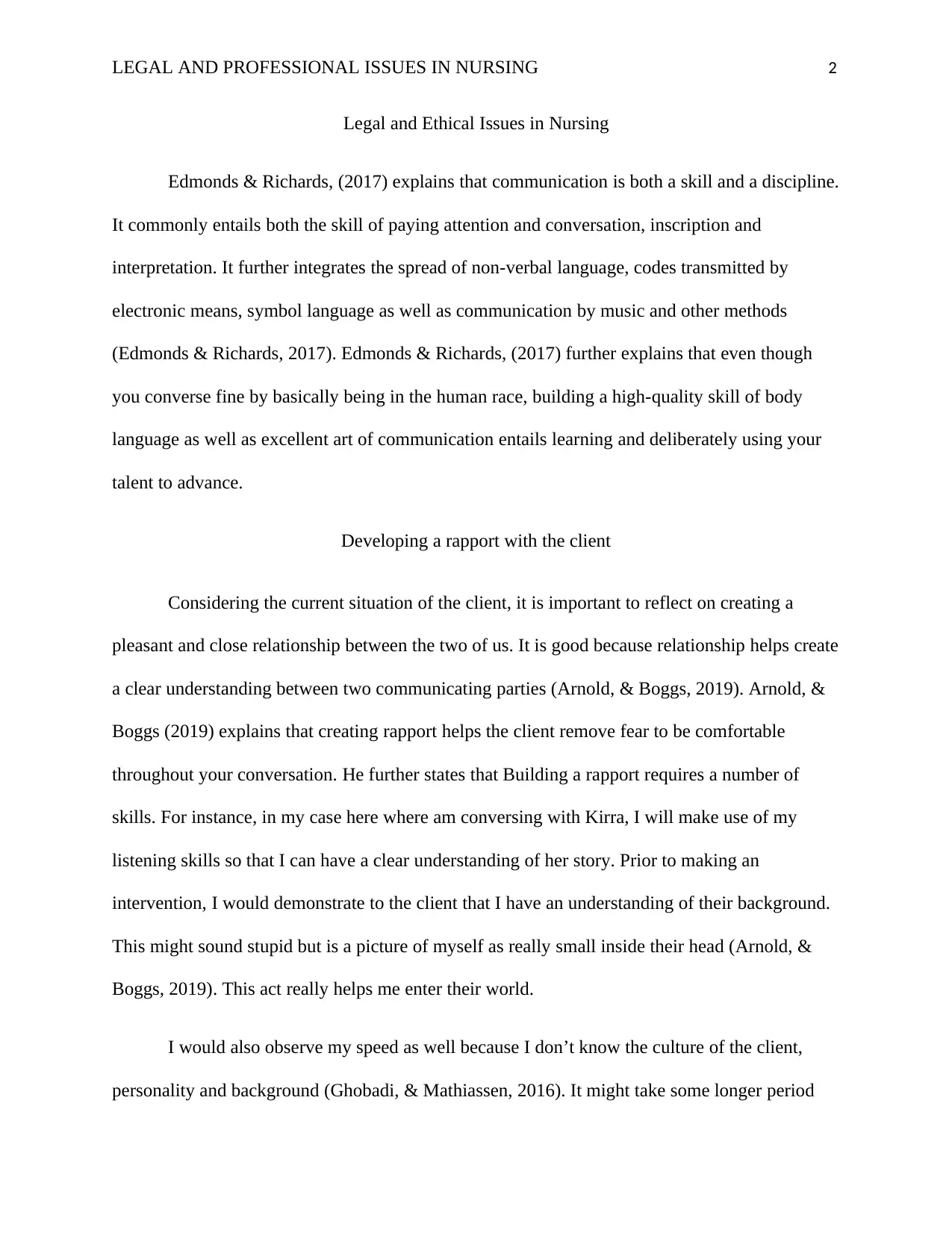
LEGAL AND PROFESSIONAL ISSUES IN NURSING 2
Legal and Ethical Issues in Nursing
Edmonds & Richards, (2017) explains that communication is both a skill and a discipline.
It commonly entails both the skill of paying attention and conversation, inscription and
interpretation. It further integrates the spread of non-verbal language, codes transmitted by
electronic means, symbol language as well as communication by music and other methods
(Edmonds & Richards, 2017). Edmonds & Richards, (2017) further explains that even though
you converse fine by basically being in the human race, building a high-quality skill of body
language as well as excellent art of communication entails learning and deliberately using your
talent to advance.
Developing a rapport with the client
Considering the current situation of the client, it is important to reflect on creating a
pleasant and close relationship between the two of us. It is good because relationship helps create
a clear understanding between two communicating parties (Arnold, & Boggs, 2019). Arnold, &
Boggs (2019) explains that creating rapport helps the client remove fear to be comfortable
throughout your conversation. He further states that Building a rapport requires a number of
skills. For instance, in my case here where am conversing with Kirra, I will make use of my
listening skills so that I can have a clear understanding of her story. Prior to making an
intervention, I would demonstrate to the client that I have an understanding of their background.
This might sound stupid but is a picture of myself as really small inside their head (Arnold, &
Boggs, 2019). This act really helps me enter their world.
I would also observe my speed as well because I don’t know the culture of the client,
personality and background (Ghobadi, & Mathiassen, 2016). It might take some longer period
Legal and Ethical Issues in Nursing
Edmonds & Richards, (2017) explains that communication is both a skill and a discipline.
It commonly entails both the skill of paying attention and conversation, inscription and
interpretation. It further integrates the spread of non-verbal language, codes transmitted by
electronic means, symbol language as well as communication by music and other methods
(Edmonds & Richards, 2017). Edmonds & Richards, (2017) further explains that even though
you converse fine by basically being in the human race, building a high-quality skill of body
language as well as excellent art of communication entails learning and deliberately using your
talent to advance.
Developing a rapport with the client
Considering the current situation of the client, it is important to reflect on creating a
pleasant and close relationship between the two of us. It is good because relationship helps create
a clear understanding between two communicating parties (Arnold, & Boggs, 2019). Arnold, &
Boggs (2019) explains that creating rapport helps the client remove fear to be comfortable
throughout your conversation. He further states that Building a rapport requires a number of
skills. For instance, in my case here where am conversing with Kirra, I will make use of my
listening skills so that I can have a clear understanding of her story. Prior to making an
intervention, I would demonstrate to the client that I have an understanding of their background.
This might sound stupid but is a picture of myself as really small inside their head (Arnold, &
Boggs, 2019). This act really helps me enter their world.
I would also observe my speed as well because I don’t know the culture of the client,
personality and background (Ghobadi, & Mathiassen, 2016). It might take some longer period
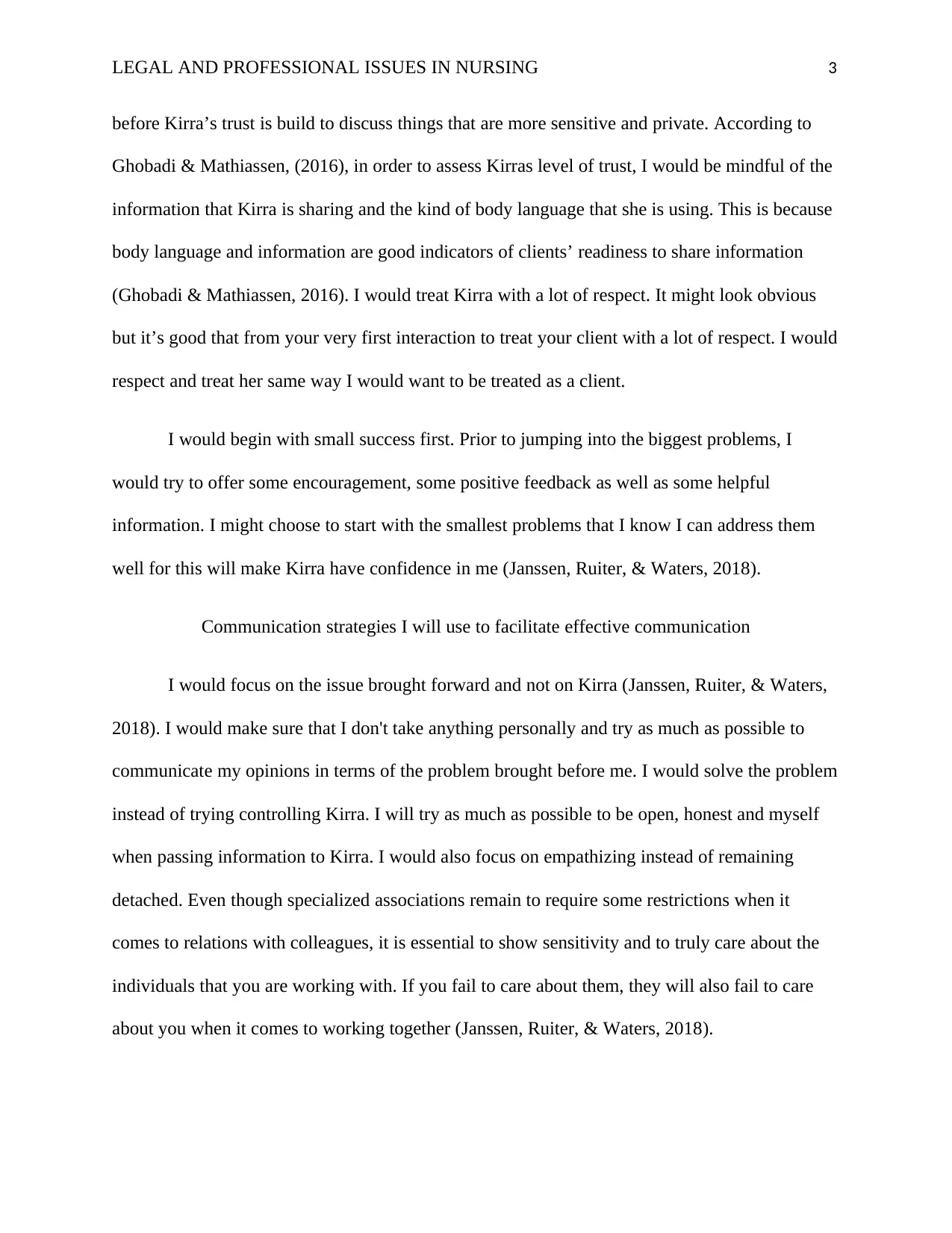
LEGAL AND PROFESSIONAL ISSUES IN NURSING 3
before Kirra’s trust is build to discuss things that are more sensitive and private. According to
Ghobadi & Mathiassen, (2016), in order to assess Kirras level of trust, I would be mindful of the
information that Kirra is sharing and the kind of body language that she is using. This is because
body language and information are good indicators of clients’ readiness to share information
(Ghobadi & Mathiassen, 2016). I would treat Kirra with a lot of respect. It might look obvious
but it’s good that from your very first interaction to treat your client with a lot of respect. I would
respect and treat her same way I would want to be treated as a client.
I would begin with small success first. Prior to jumping into the biggest problems, I
would try to offer some encouragement, some positive feedback as well as some helpful
information. I might choose to start with the smallest problems that I know I can address them
well for this will make Kirra have confidence in me (Janssen, Ruiter, & Waters, 2018).
Communication strategies I will use to facilitate effective communication
I would focus on the issue brought forward and not on Kirra (Janssen, Ruiter, & Waters,
2018). I would make sure that I don't take anything personally and try as much as possible to
communicate my opinions in terms of the problem brought before me. I would solve the problem
instead of trying controlling Kirra. I will try as much as possible to be open, honest and myself
when passing information to Kirra. I would also focus on empathizing instead of remaining
detached. Even though specialized associations remain to require some restrictions when it
comes to relations with colleagues, it is essential to show sensitivity and to truly care about the
individuals that you are working with. If you fail to care about them, they will also fail to care
about you when it comes to working together (Janssen, Ruiter, & Waters, 2018).
before Kirra’s trust is build to discuss things that are more sensitive and private. According to
Ghobadi & Mathiassen, (2016), in order to assess Kirras level of trust, I would be mindful of the
information that Kirra is sharing and the kind of body language that she is using. This is because
body language and information are good indicators of clients’ readiness to share information
(Ghobadi & Mathiassen, 2016). I would treat Kirra with a lot of respect. It might look obvious
but it’s good that from your very first interaction to treat your client with a lot of respect. I would
respect and treat her same way I would want to be treated as a client.
I would begin with small success first. Prior to jumping into the biggest problems, I
would try to offer some encouragement, some positive feedback as well as some helpful
information. I might choose to start with the smallest problems that I know I can address them
well for this will make Kirra have confidence in me (Janssen, Ruiter, & Waters, 2018).
Communication strategies I will use to facilitate effective communication
I would focus on the issue brought forward and not on Kirra (Janssen, Ruiter, & Waters,
2018). I would make sure that I don't take anything personally and try as much as possible to
communicate my opinions in terms of the problem brought before me. I would solve the problem
instead of trying controlling Kirra. I will try as much as possible to be open, honest and myself
when passing information to Kirra. I would also focus on empathizing instead of remaining
detached. Even though specialized associations remain to require some restrictions when it
comes to relations with colleagues, it is essential to show sensitivity and to truly care about the
individuals that you are working with. If you fail to care about them, they will also fail to care
about you when it comes to working together (Janssen, Ruiter, & Waters, 2018).
⊘ This is a preview!⊘
Do you want full access?
Subscribe today to unlock all pages.

Trusted by 1+ million students worldwide
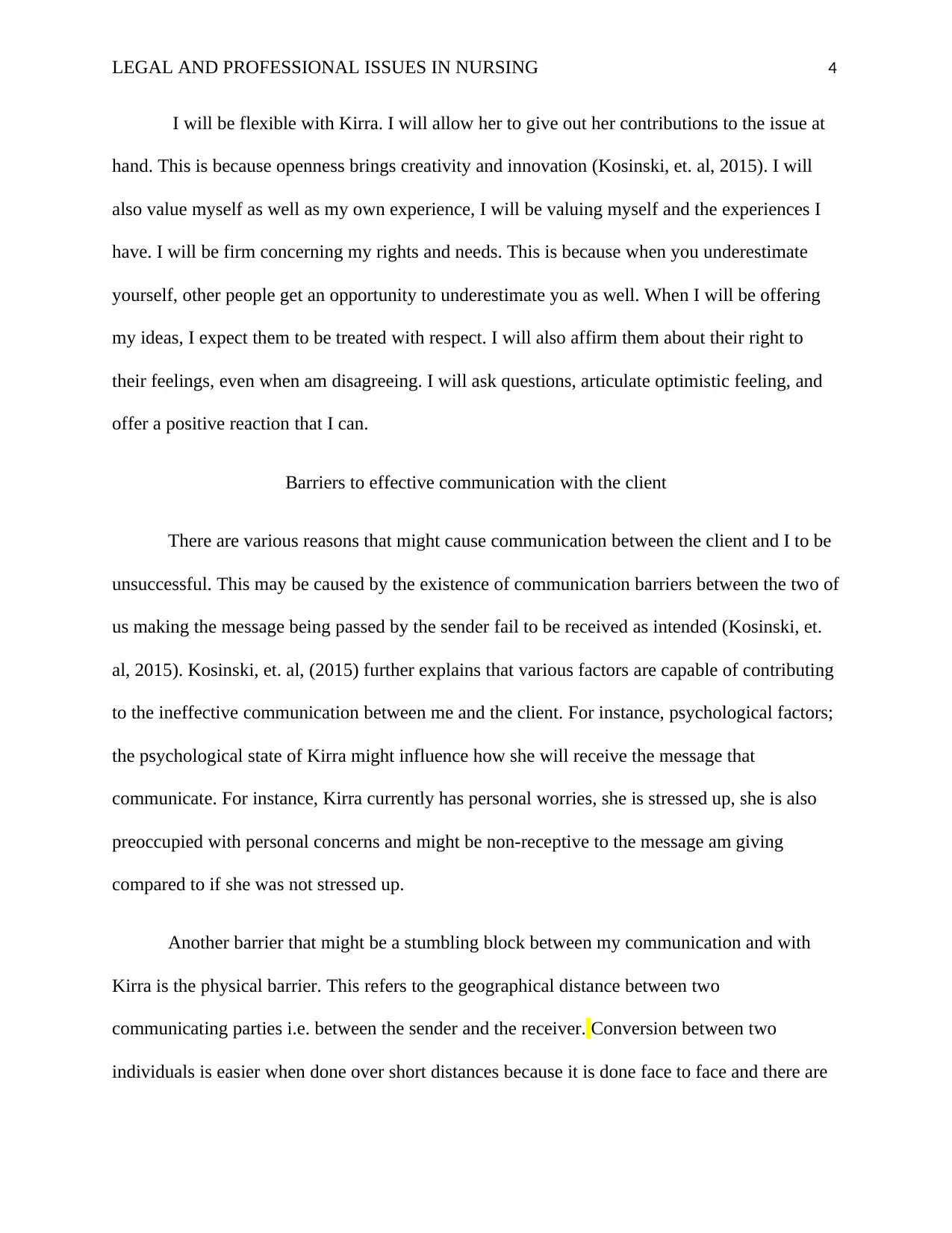
LEGAL AND PROFESSIONAL ISSUES IN NURSING 4
I will be flexible with Kirra. I will allow her to give out her contributions to the issue at
hand. This is because openness brings creativity and innovation (Kosinski, et. al, 2015). I will
also value myself as well as my own experience, I will be valuing myself and the experiences I
have. I will be firm concerning my rights and needs. This is because when you underestimate
yourself, other people get an opportunity to underestimate you as well. When I will be offering
my ideas, I expect them to be treated with respect. I will also affirm them about their right to
their feelings, even when am disagreeing. I will ask questions, articulate optimistic feeling, and
offer a positive reaction that I can.
Barriers to effective communication with the client
There are various reasons that might cause communication between the client and I to be
unsuccessful. This may be caused by the existence of communication barriers between the two of
us making the message being passed by the sender fail to be received as intended (Kosinski, et.
al, 2015). Kosinski, et. al, (2015) further explains that various factors are capable of contributing
to the ineffective communication between me and the client. For instance, psychological factors;
the psychological state of Kirra might influence how she will receive the message that
communicate. For instance, Kirra currently has personal worries, she is stressed up, she is also
preoccupied with personal concerns and might be non-receptive to the message am giving
compared to if she was not stressed up.
Another barrier that might be a stumbling block between my communication and with
Kirra is the physical barrier. This refers to the geographical distance between two
communicating parties i.e. between the sender and the receiver. Conversion between two
individuals is easier when done over short distances because it is done face to face and there are
I will be flexible with Kirra. I will allow her to give out her contributions to the issue at
hand. This is because openness brings creativity and innovation (Kosinski, et. al, 2015). I will
also value myself as well as my own experience, I will be valuing myself and the experiences I
have. I will be firm concerning my rights and needs. This is because when you underestimate
yourself, other people get an opportunity to underestimate you as well. When I will be offering
my ideas, I expect them to be treated with respect. I will also affirm them about their right to
their feelings, even when am disagreeing. I will ask questions, articulate optimistic feeling, and
offer a positive reaction that I can.
Barriers to effective communication with the client
There are various reasons that might cause communication between the client and I to be
unsuccessful. This may be caused by the existence of communication barriers between the two of
us making the message being passed by the sender fail to be received as intended (Kosinski, et.
al, 2015). Kosinski, et. al, (2015) further explains that various factors are capable of contributing
to the ineffective communication between me and the client. For instance, psychological factors;
the psychological state of Kirra might influence how she will receive the message that
communicate. For instance, Kirra currently has personal worries, she is stressed up, she is also
preoccupied with personal concerns and might be non-receptive to the message am giving
compared to if she was not stressed up.
Another barrier that might be a stumbling block between my communication and with
Kirra is the physical barrier. This refers to the geographical distance between two
communicating parties i.e. between the sender and the receiver. Conversion between two
individuals is easier when done over short distances because it is done face to face and there are
Paraphrase This Document
Need a fresh take? Get an instant paraphrase of this document with our AI Paraphraser
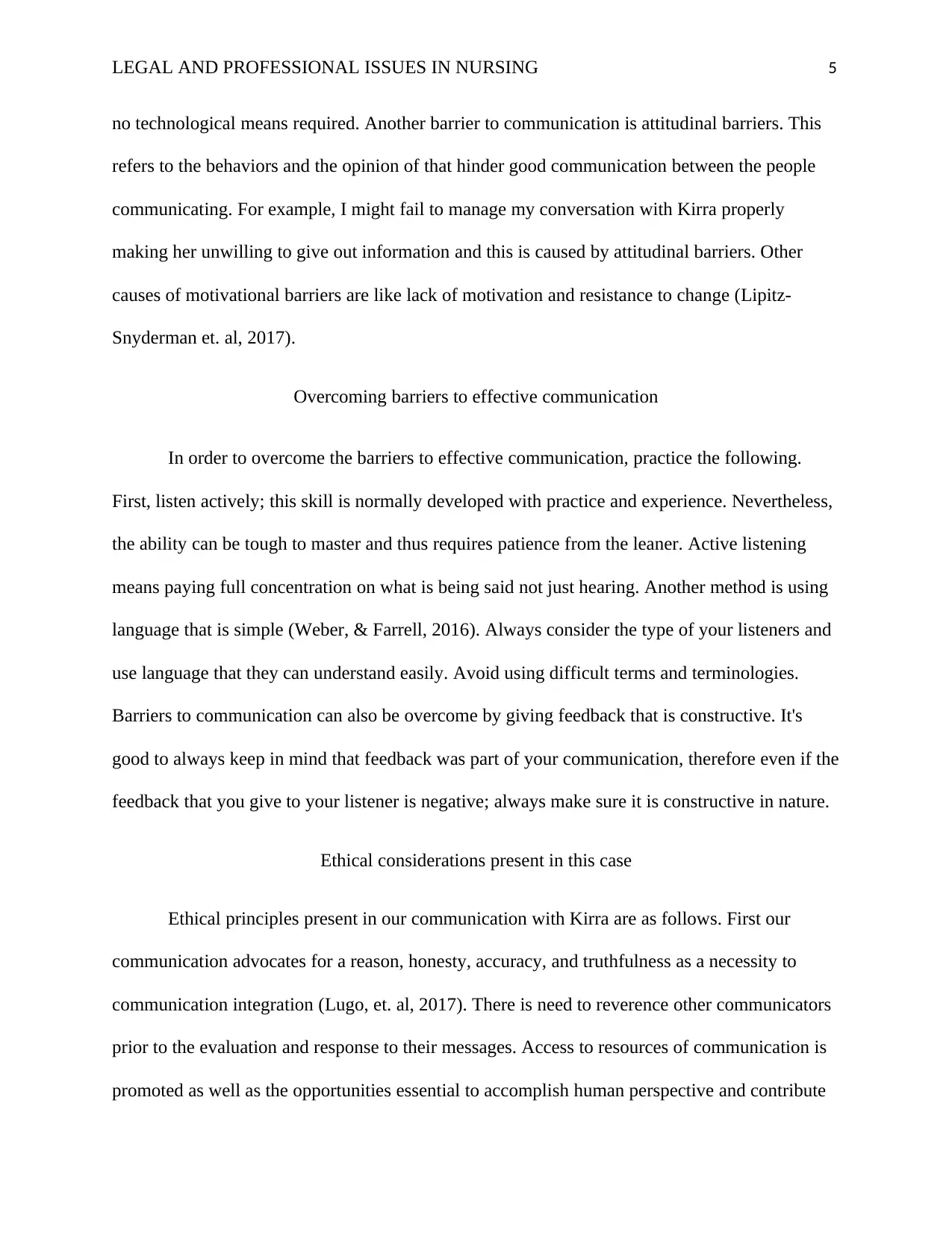
LEGAL AND PROFESSIONAL ISSUES IN NURSING 5
no technological means required. Another barrier to communication is attitudinal barriers. This
refers to the behaviors and the opinion of that hinder good communication between the people
communicating. For example, I might fail to manage my conversation with Kirra properly
making her unwilling to give out information and this is caused by attitudinal barriers. Other
causes of motivational barriers are like lack of motivation and resistance to change (Lipitz-
Snyderman et. al, 2017).
Overcoming barriers to effective communication
In order to overcome the barriers to effective communication, practice the following.
First, listen actively; this skill is normally developed with practice and experience. Nevertheless,
the ability can be tough to master and thus requires patience from the leaner. Active listening
means paying full concentration on what is being said not just hearing. Another method is using
language that is simple (Weber, & Farrell, 2016). Always consider the type of your listeners and
use language that they can understand easily. Avoid using difficult terms and terminologies.
Barriers to communication can also be overcome by giving feedback that is constructive. It's
good to always keep in mind that feedback was part of your communication, therefore even if the
feedback that you give to your listener is negative; always make sure it is constructive in nature.
Ethical considerations present in this case
Ethical principles present in our communication with Kirra are as follows. First our
communication advocates for a reason, honesty, accuracy, and truthfulness as a necessity to
communication integration (Lugo, et. al, 2017). There is need to reverence other communicators
prior to the evaluation and response to their messages. Access to resources of communication is
promoted as well as the opportunities essential to accomplish human perspective and contribute
no technological means required. Another barrier to communication is attitudinal barriers. This
refers to the behaviors and the opinion of that hinder good communication between the people
communicating. For example, I might fail to manage my conversation with Kirra properly
making her unwilling to give out information and this is caused by attitudinal barriers. Other
causes of motivational barriers are like lack of motivation and resistance to change (Lipitz-
Snyderman et. al, 2017).
Overcoming barriers to effective communication
In order to overcome the barriers to effective communication, practice the following.
First, listen actively; this skill is normally developed with practice and experience. Nevertheless,
the ability can be tough to master and thus requires patience from the leaner. Active listening
means paying full concentration on what is being said not just hearing. Another method is using
language that is simple (Weber, & Farrell, 2016). Always consider the type of your listeners and
use language that they can understand easily. Avoid using difficult terms and terminologies.
Barriers to communication can also be overcome by giving feedback that is constructive. It's
good to always keep in mind that feedback was part of your communication, therefore even if the
feedback that you give to your listener is negative; always make sure it is constructive in nature.
Ethical considerations present in this case
Ethical principles present in our communication with Kirra are as follows. First our
communication advocates for a reason, honesty, accuracy, and truthfulness as a necessity to
communication integration (Lugo, et. al, 2017). There is need to reverence other communicators
prior to the evaluation and response to their messages. Access to resources of communication is
promoted as well as the opportunities essential to accomplish human perspective and contribute
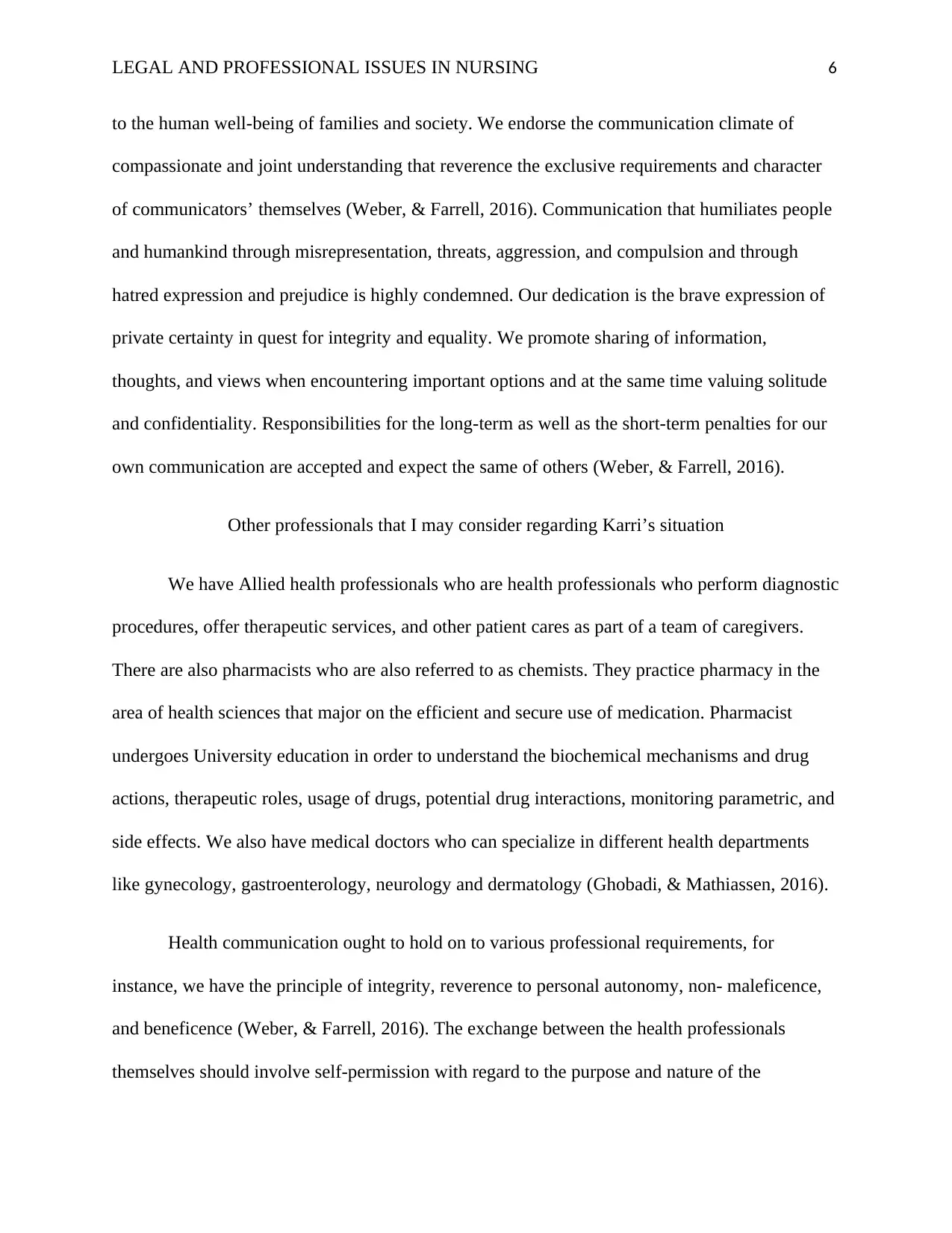
LEGAL AND PROFESSIONAL ISSUES IN NURSING 6
to the human well-being of families and society. We endorse the communication climate of
compassionate and joint understanding that reverence the exclusive requirements and character
of communicators’ themselves (Weber, & Farrell, 2016). Communication that humiliates people
and humankind through misrepresentation, threats, aggression, and compulsion and through
hatred expression and prejudice is highly condemned. Our dedication is the brave expression of
private certainty in quest for integrity and equality. We promote sharing of information,
thoughts, and views when encountering important options and at the same time valuing solitude
and confidentiality. Responsibilities for the long-term as well as the short-term penalties for our
own communication are accepted and expect the same of others (Weber, & Farrell, 2016).
Other professionals that I may consider regarding Karri’s situation
We have Allied health professionals who are health professionals who perform diagnostic
procedures, offer therapeutic services, and other patient cares as part of a team of caregivers.
There are also pharmacists who are also referred to as chemists. They practice pharmacy in the
area of health sciences that major on the efficient and secure use of medication. Pharmacist
undergoes University education in order to understand the biochemical mechanisms and drug
actions, therapeutic roles, usage of drugs, potential drug interactions, monitoring parametric, and
side effects. We also have medical doctors who can specialize in different health departments
like gynecology, gastroenterology, neurology and dermatology (Ghobadi, & Mathiassen, 2016).
Health communication ought to hold on to various professional requirements, for
instance, we have the principle of integrity, reverence to personal autonomy, non- maleficence,
and beneficence (Weber, & Farrell, 2016). The exchange between the health professionals
themselves should involve self-permission with regard to the purpose and nature of the
to the human well-being of families and society. We endorse the communication climate of
compassionate and joint understanding that reverence the exclusive requirements and character
of communicators’ themselves (Weber, & Farrell, 2016). Communication that humiliates people
and humankind through misrepresentation, threats, aggression, and compulsion and through
hatred expression and prejudice is highly condemned. Our dedication is the brave expression of
private certainty in quest for integrity and equality. We promote sharing of information,
thoughts, and views when encountering important options and at the same time valuing solitude
and confidentiality. Responsibilities for the long-term as well as the short-term penalties for our
own communication are accepted and expect the same of others (Weber, & Farrell, 2016).
Other professionals that I may consider regarding Karri’s situation
We have Allied health professionals who are health professionals who perform diagnostic
procedures, offer therapeutic services, and other patient cares as part of a team of caregivers.
There are also pharmacists who are also referred to as chemists. They practice pharmacy in the
area of health sciences that major on the efficient and secure use of medication. Pharmacist
undergoes University education in order to understand the biochemical mechanisms and drug
actions, therapeutic roles, usage of drugs, potential drug interactions, monitoring parametric, and
side effects. We also have medical doctors who can specialize in different health departments
like gynecology, gastroenterology, neurology and dermatology (Ghobadi, & Mathiassen, 2016).
Health communication ought to hold on to various professional requirements, for
instance, we have the principle of integrity, reverence to personal autonomy, non- maleficence,
and beneficence (Weber, & Farrell, 2016). The exchange between the health professionals
themselves should involve self-permission with regard to the purpose and nature of the
⊘ This is a preview!⊘
Do you want full access?
Subscribe today to unlock all pages.

Trusted by 1+ million students worldwide
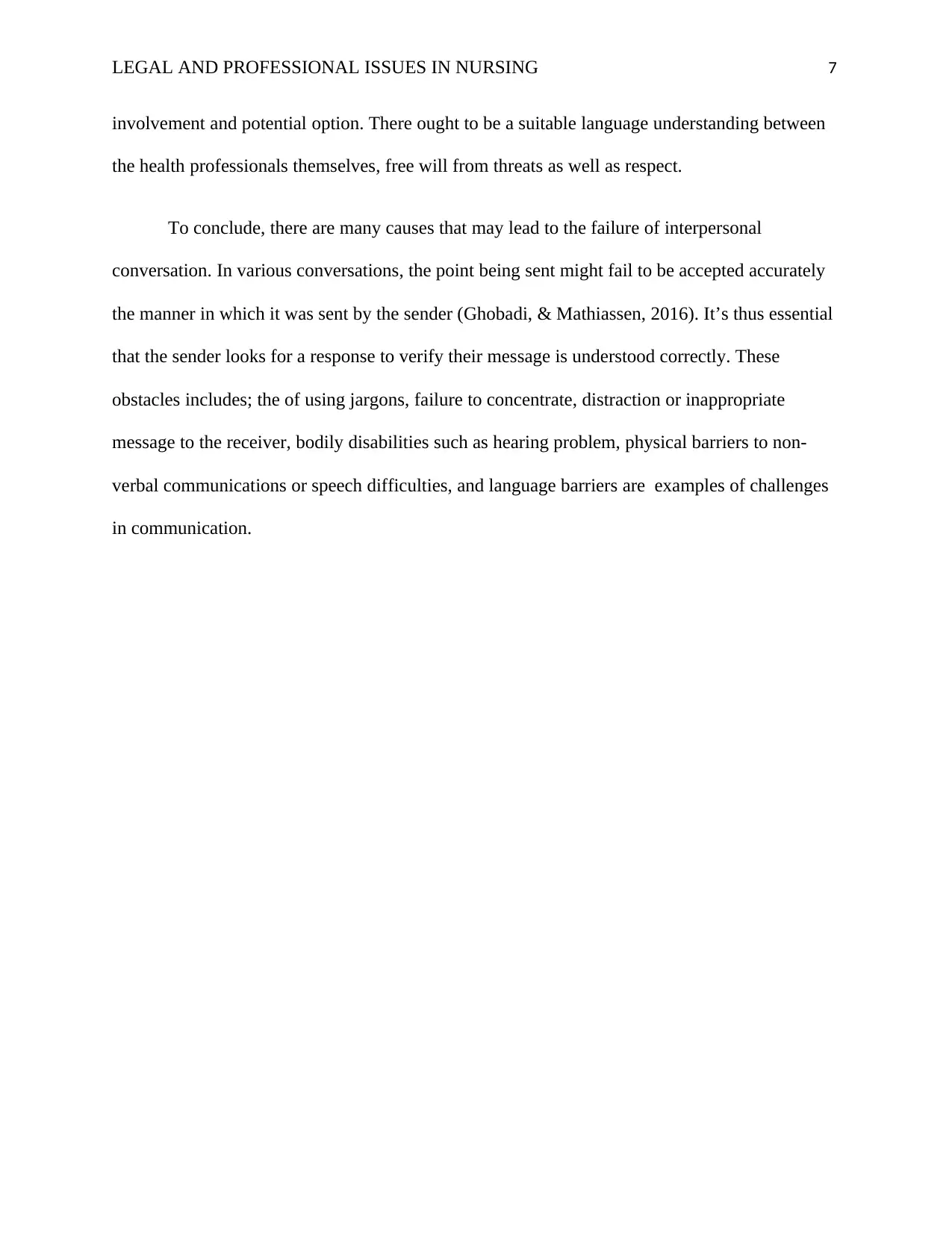
LEGAL AND PROFESSIONAL ISSUES IN NURSING 7
involvement and potential option. There ought to be a suitable language understanding between
the health professionals themselves, free will from threats as well as respect.
To conclude, there are many causes that may lead to the failure of interpersonal
conversation. In various conversations, the point being sent might fail to be accepted accurately
the manner in which it was sent by the sender (Ghobadi, & Mathiassen, 2016). It’s thus essential
that the sender looks for a response to verify their message is understood correctly. These
obstacles includes; the of using jargons, failure to concentrate, distraction or inappropriate
message to the receiver, bodily disabilities such as hearing problem, physical barriers to non-
verbal communications or speech difficulties, and language barriers are examples of challenges
in communication.
involvement and potential option. There ought to be a suitable language understanding between
the health professionals themselves, free will from threats as well as respect.
To conclude, there are many causes that may lead to the failure of interpersonal
conversation. In various conversations, the point being sent might fail to be accepted accurately
the manner in which it was sent by the sender (Ghobadi, & Mathiassen, 2016). It’s thus essential
that the sender looks for a response to verify their message is understood correctly. These
obstacles includes; the of using jargons, failure to concentrate, distraction or inappropriate
message to the receiver, bodily disabilities such as hearing problem, physical barriers to non-
verbal communications or speech difficulties, and language barriers are examples of challenges
in communication.
Paraphrase This Document
Need a fresh take? Get an instant paraphrase of this document with our AI Paraphraser
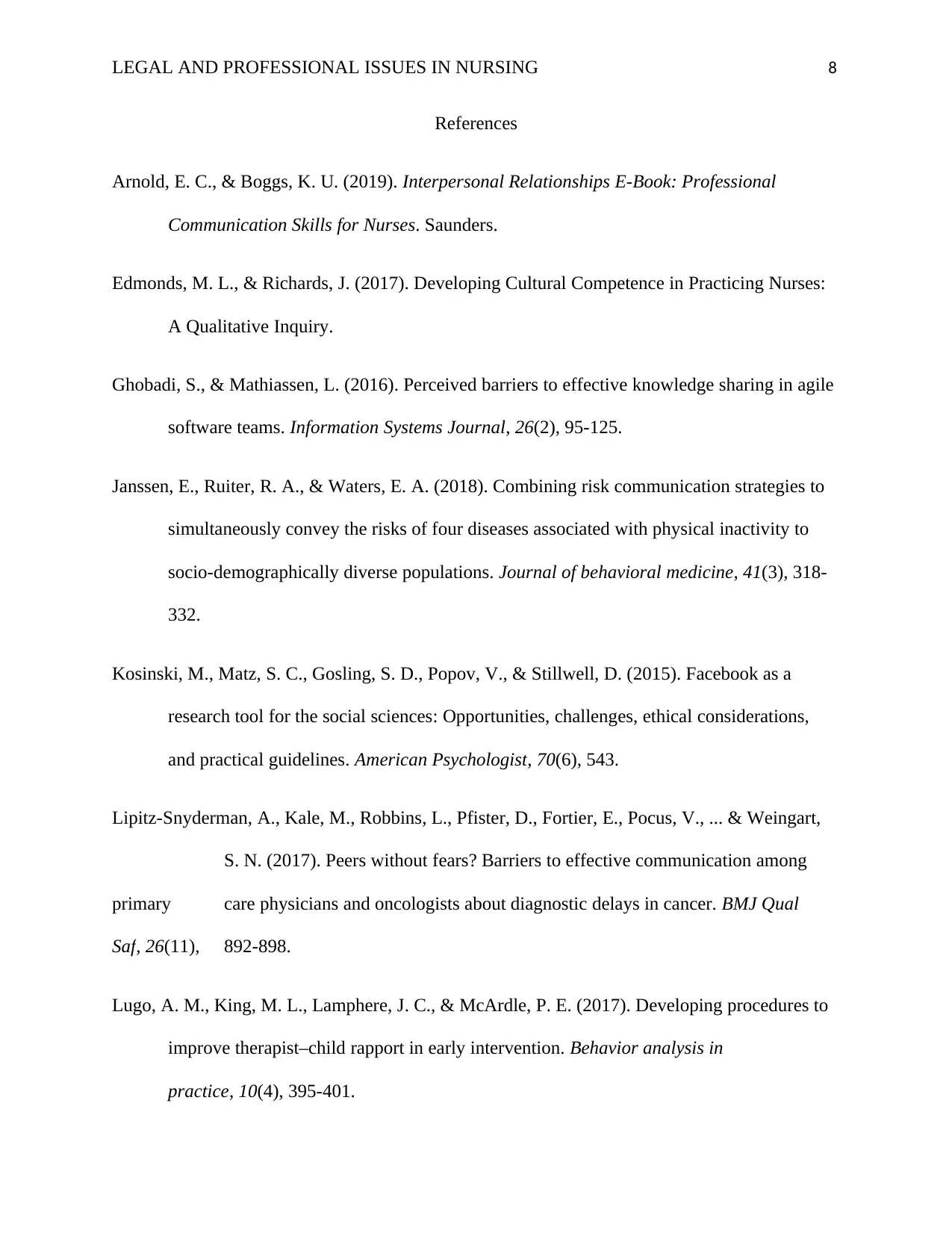
LEGAL AND PROFESSIONAL ISSUES IN NURSING 8
References
Arnold, E. C., & Boggs, K. U. (2019). Interpersonal Relationships E-Book: Professional
Communication Skills for Nurses. Saunders.
Edmonds, M. L., & Richards, J. (2017). Developing Cultural Competence in Practicing Nurses:
A Qualitative Inquiry.
Ghobadi, S., & Mathiassen, L. (2016). Perceived barriers to effective knowledge sharing in agile
software teams. Information Systems Journal, 26(2), 95-125.
Janssen, E., Ruiter, R. A., & Waters, E. A. (2018). Combining risk communication strategies to
simultaneously convey the risks of four diseases associated with physical inactivity to
socio-demographically diverse populations. Journal of behavioral medicine, 41(3), 318-
332.
Kosinski, M., Matz, S. C., Gosling, S. D., Popov, V., & Stillwell, D. (2015). Facebook as a
research tool for the social sciences: Opportunities, challenges, ethical considerations,
and practical guidelines. American Psychologist, 70(6), 543.
Lipitz-Snyderman, A., Kale, M., Robbins, L., Pfister, D., Fortier, E., Pocus, V., ... & Weingart,
S. N. (2017). Peers without fears? Barriers to effective communication among
primary care physicians and oncologists about diagnostic delays in cancer. BMJ Qual
Saf, 26(11), 892-898.
Lugo, A. M., King, M. L., Lamphere, J. C., & McArdle, P. E. (2017). Developing procedures to
improve therapist–child rapport in early intervention. Behavior analysis in
practice, 10(4), 395-401.
References
Arnold, E. C., & Boggs, K. U. (2019). Interpersonal Relationships E-Book: Professional
Communication Skills for Nurses. Saunders.
Edmonds, M. L., & Richards, J. (2017). Developing Cultural Competence in Practicing Nurses:
A Qualitative Inquiry.
Ghobadi, S., & Mathiassen, L. (2016). Perceived barriers to effective knowledge sharing in agile
software teams. Information Systems Journal, 26(2), 95-125.
Janssen, E., Ruiter, R. A., & Waters, E. A. (2018). Combining risk communication strategies to
simultaneously convey the risks of four diseases associated with physical inactivity to
socio-demographically diverse populations. Journal of behavioral medicine, 41(3), 318-
332.
Kosinski, M., Matz, S. C., Gosling, S. D., Popov, V., & Stillwell, D. (2015). Facebook as a
research tool for the social sciences: Opportunities, challenges, ethical considerations,
and practical guidelines. American Psychologist, 70(6), 543.
Lipitz-Snyderman, A., Kale, M., Robbins, L., Pfister, D., Fortier, E., Pocus, V., ... & Weingart,
S. N. (2017). Peers without fears? Barriers to effective communication among
primary care physicians and oncologists about diagnostic delays in cancer. BMJ Qual
Saf, 26(11), 892-898.
Lugo, A. M., King, M. L., Lamphere, J. C., & McArdle, P. E. (2017). Developing procedures to
improve therapist–child rapport in early intervention. Behavior analysis in
practice, 10(4), 395-401.
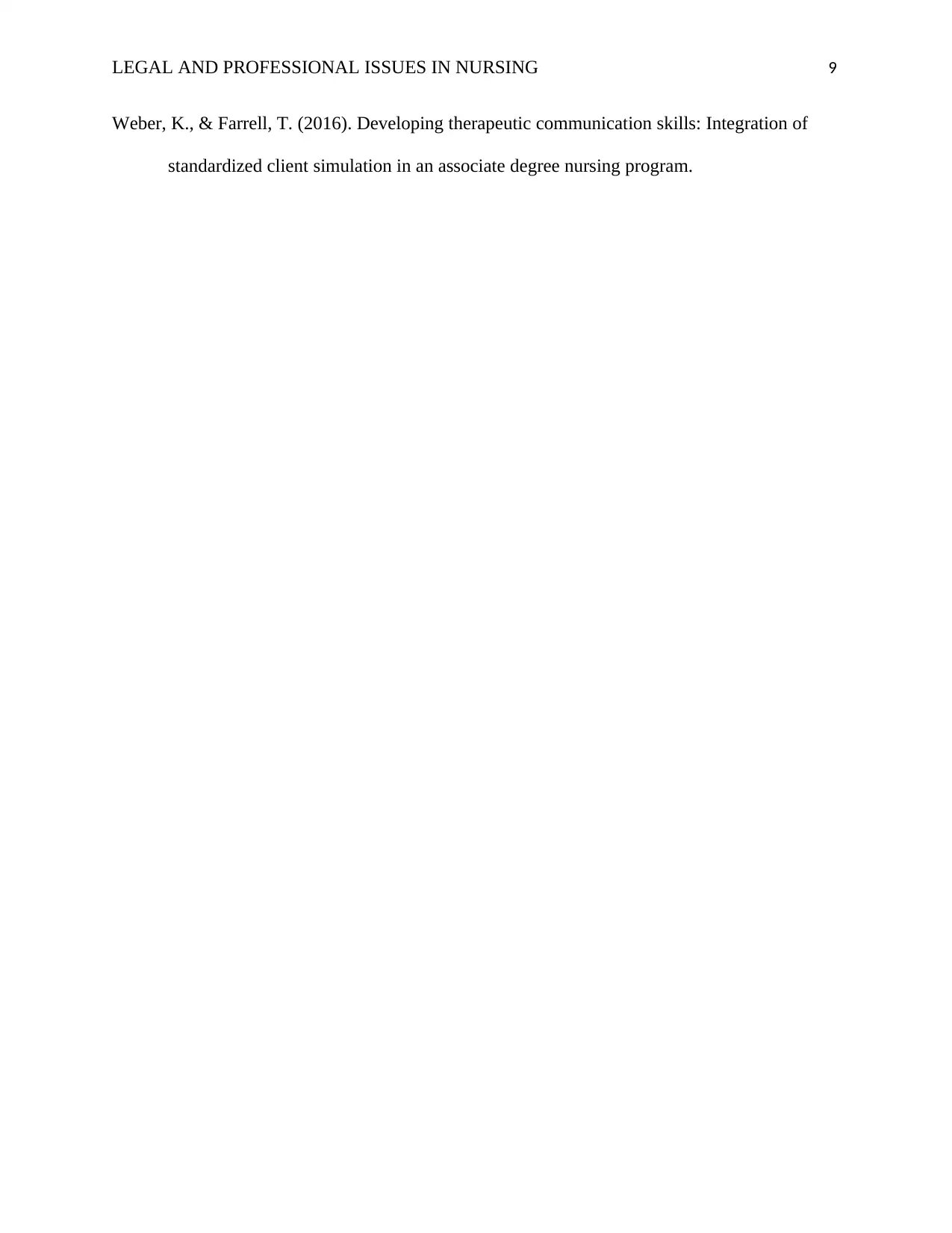
LEGAL AND PROFESSIONAL ISSUES IN NURSING 9
Weber, K., & Farrell, T. (2016). Developing therapeutic communication skills: Integration of
standardized client simulation in an associate degree nursing program.
Weber, K., & Farrell, T. (2016). Developing therapeutic communication skills: Integration of
standardized client simulation in an associate degree nursing program.
⊘ This is a preview!⊘
Do you want full access?
Subscribe today to unlock all pages.

Trusted by 1+ million students worldwide
1 out of 9
Your All-in-One AI-Powered Toolkit for Academic Success.
+13062052269
info@desklib.com
Available 24*7 on WhatsApp / Email
![[object Object]](/_next/static/media/star-bottom.7253800d.svg)
Unlock your academic potential
Copyright © 2020–2025 A2Z Services. All Rights Reserved. Developed and managed by ZUCOL.
